
Lethal Architecture
Housing (low cost social housing as well as luxury dwellings) has been the major raison d’être of generations of European architects. American architects must be congratulated for not having made the same poor choice of raison d’être. Housing is not architecture. An odyssey through a series of iconographic housing catastrophes, from the (fake) demolition of John Lautner’s Garcia House in Los Angeles (in Richard Donner’s film Lethal Weapon 2, featuring cops turned demolition men Mel Gibson and Danny Glover), by way of the (very real) demolition of the Pruitt–Igoe housing development in St. Louis, to (the not at all demolished) Farnsworth House by Ludwig Mies van der Rohe.
Lethal Architecture 1: America
When Mel Gibson ties a cable between his truck and the slender stilts which support the elegant house in the hills in which the South African bad guys in Richard Donner’s Lethal Weapon 2 (1989) do their dirty business, and drives away on top speed, pulling the steel stilts away from under the house, making the whole house collapse and crash into the valley below, engulfed in a blaze of thunder and fire—it is not just any house or studio prop that has been demolished; it is the eye-shaped Garcia House in Los Angeles, designed by John Lautner in 1962.
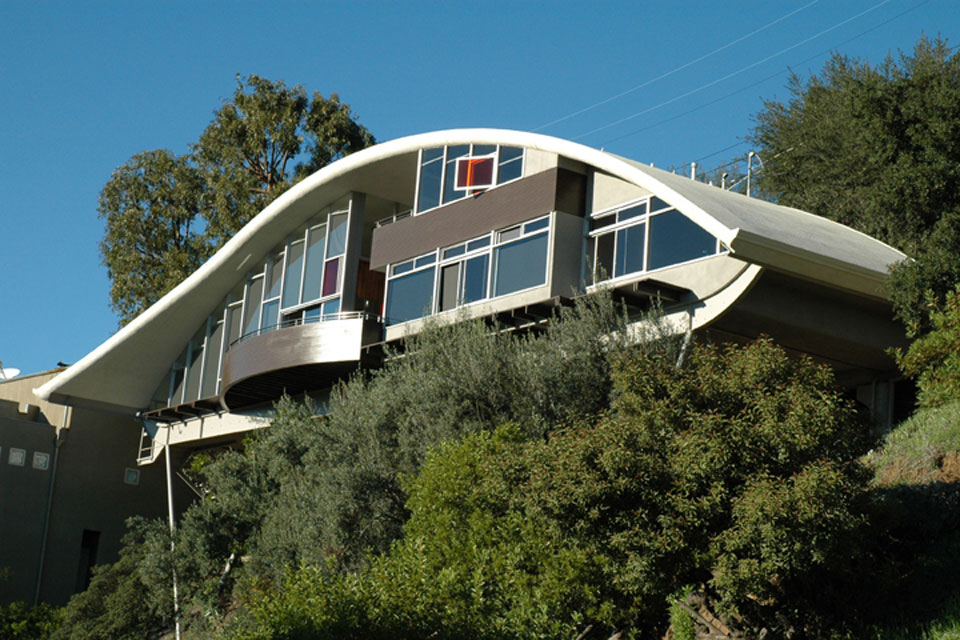
Or should i say, it is of course a perfect full-scale copy of the Garcia House. Getting the owner’s permission to use the real Garcia House even for the indoor scenes of such a film would be impossible because of much gun fire and shattering of glass.

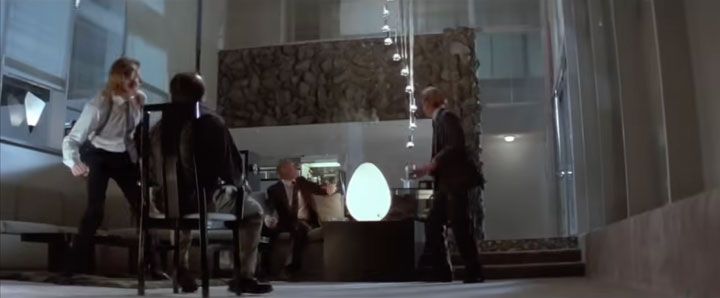
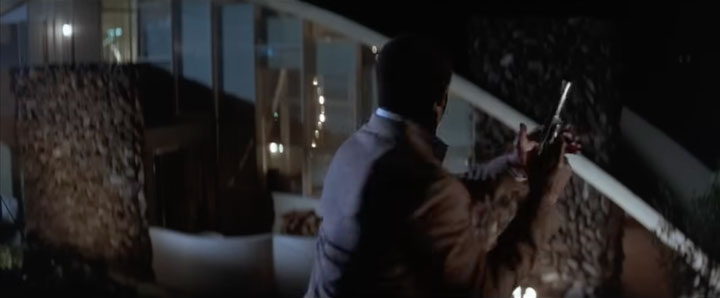







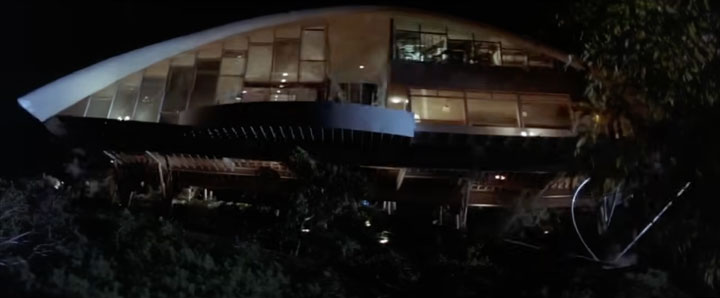



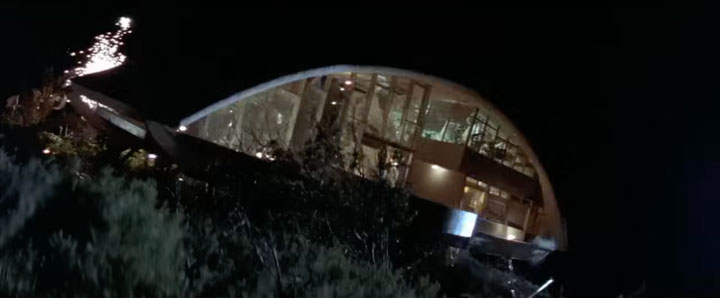
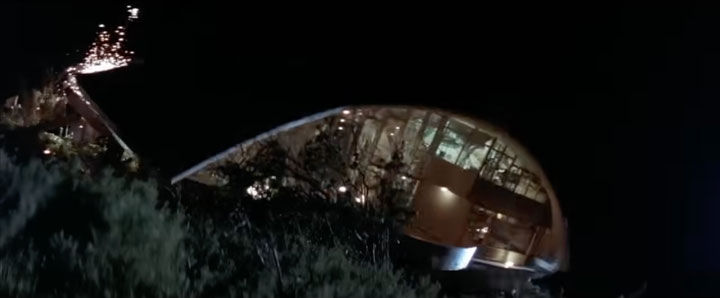





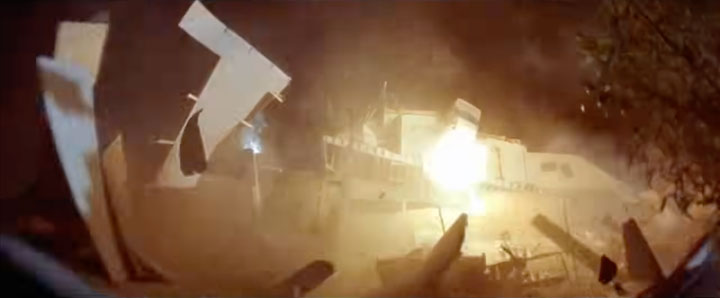


However, such architectural cameos are rare in American imagery. In American film and television, even the houses of the affluent upper middle class, with well kept gardens in safe suburbs, or the mansions of the very rich indeed, are hardly ever examples of high architecture (from fr. haute, high, as in haute couture) like the Garcia House, not even bad
or poor
architecture, just non-architecture, the kind of houses people inhabit in films like Steven Spielberg’s E.T. (1982), or Tobe Hooper’s Poltergeist (1982).
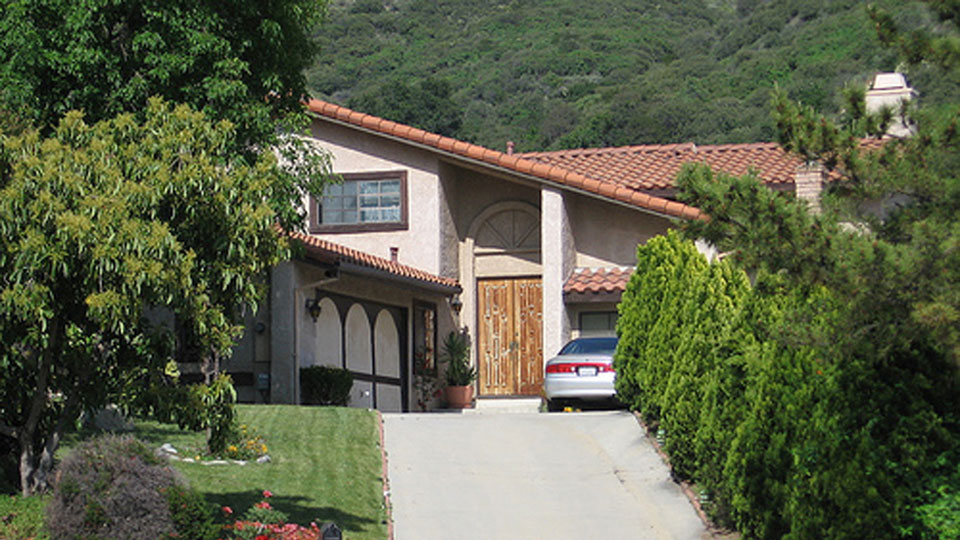
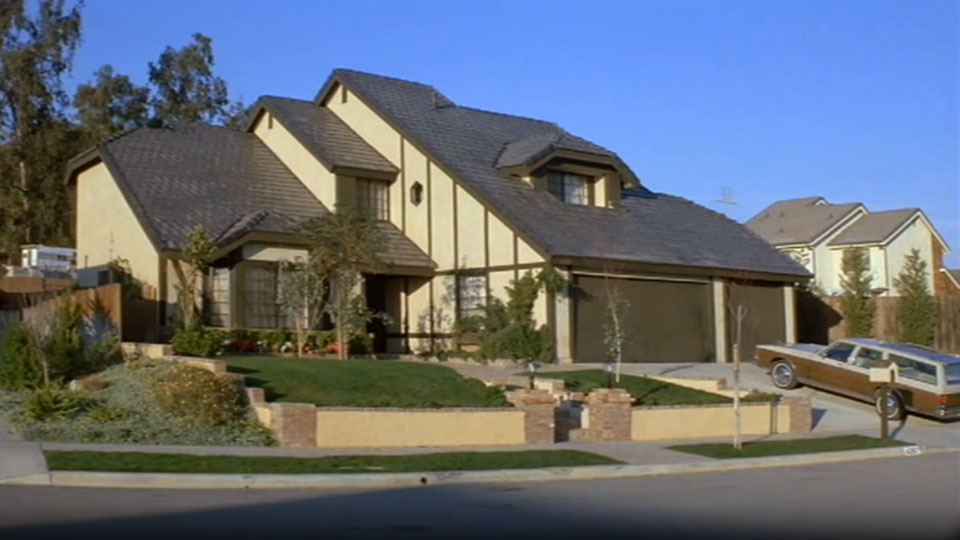
Such houses never appear in American high architecture publications. They are too eclectic to be taken seriously
and are dismissed as mediocre pastiches of historical and semi-modern styles.
Mind you, these non-architecture houses are perfectly decent and well-functioning. They have walls, a roof, windows, a porch, a garage, a driveway. Furthermore, they are spacious. They are warm in the winter and kept cool in the summer. Often there is one bathroom for every bedroom. One can have high standards of living without having high architecture.
The lack of interest in housing as a field for high architecture is typical not just for the American entertainment industry. Any visitor to the U.S. will note that the imagery of the film industry gives a fair representation of the real life situation: in America, architects design airports, skyscrapers and the like, leaving the housing market to entrepreneurs and speculators. Apparently, there are no complaints about this, and there is no notion within the architectural profession that the situation could, or should, be different.
There are exceptions, of course. Many of the world’s greatest examples of high architecture for living in are American. But such houses are as rare in real life as in the movies. In America, the private dwelling designed by an architect in a high architecture style—be it mass housing or luxury beach houses—is the exception, not the rule.
The fact that in America, architects as a rule do not design the housing, is a most annoying fact to Europeans. The ugly
homes of Americans cause the kind of neurotic frustration in European architects that all purist intellectuals will experience on arrival to America. There have been a great many self-appointed European reformers to American culture, however they never leave much of a mark. They may have some success for a limited period of time in a limited sector of society, but in the end they always leave Americans profoundly unimpressed and indifferent.
Lethal Architecture 2: Europe
In Europe things are different, to say the least. In the decades immediately following World War II, housing (social housing in particular) was—not just a subject matter, but—the subject matter and the mission of European architects.
And in the minds and spirits of many, this is the case still today. Making housing the raison d’être of European twentieth century architecture was a collective stand taken by the entire architectural establishment after collectively adopting the following values:
2. That designing Egyptian pyramids, Greek temples, gothic cathedrals, imperial palaces, luxurious manor houses, fascist chancelleries, and the like (the whole history of architecture, as it were) was bad, because these, albeit magnificent edifices, were all expressions of power structures that were certainly undemocratic, and very often served the execution of tyranny.
3. That architects in modern society must refuse serving such undemocratic purposes.
One very consistent conclusion from these concerns and these worries about democracy would have been to refuse to practice architecture, to close architecture schools, to have architects drive taxis instead, or whatever. But architects like designing. They do not want to give it up for any reason. Therefore, instead of refusing to practice architecture and closing architecture schools, architects chose only to change the subject of their professional practice, and to extend professional concern into new realms. Architects turned to social housing.
Thanks to social housing they could go on designing without feeling so bad about it. Traditionally, providing mass housing had not been a major concern of architects, nor of rulers. Suddenly there was no greater virtue for an architect than to design good
social housing and, for once, to promote democracy
in architecture—through architectural designs that were supposedly good for people.
In architecture schools, students were being told and encouraged to firmly believe that they are saviors and do-gooders, not really serving the commercial developer or government which would hire them and pay their salaries, but first and foremost serving the user,
that weaker member of society who cannot stand up for himself against the bad guys (e.g. commercial builders who will exploit them, or what have you).
This is how social housing became the raison d’être for the whole discipline of high architecture in Europe. Turning the nondescript non-architecture into high architecture was an excuse for the purist idealists and moralists on this side of the Atlantic Ocean to be able to keep on designing. However, it is a well known fact that the road to hell is paved with good intentions. In retrospect, the problems of post-war high architecture social housing have been great—class segregation, over-representation of crime and domestic violence, etc. If you are unlucky, living in the wrong neighborhood and being in the wrong place at the wrong time will actually kill you (social housing = lethal housing).
Such problems, and problematic neighborhoods, have always been around, of course, but the striking thing is that the social housing of past decades was designed to be good for people,
to be better for, and more useful
to people than the cathedrals and palaces of past centuries.
All European architects really hate being asked this question: Why did (European) architects design such terribly
Unfortunately, it is probably the most common question of all when laymen in Europe make an effort to strike up a conversation about architecture with an architect. The architect will most likely have a different opinion than the layman about what kind of buildings are ugly
and unpleasant
concrete high-rise social housing suburbs in the sixties/seventies?terrible
(for some time now it has been quite in
among cutting-edge architects, after a period of cold feet, soul-searching and making amends, to like
sixties/seventies suburbias), but on the whole the problems of post-war social housing in Europe are difficult to get around. The usual answers to the question, like If only this or that had been done in a better way, with more such and such, it would all have turned out much better,
really are not good enough. What, then, would the this
or that
and such and such
be which would have made it all turn out nicely? Really all of it?
Social housing looks exactly the same all over the world. It looks the same on both sides of what used to be called the Iron Curtain. Good
architect or bad
architect matters little for the success or failure of a social housing project. It obviously is not a question of the quality of architectural design. The irritation and discomfort of the interrogated architect does not come from the layman’s question being stupid or obnoxious, but from not having a good answer—not even after trying to answer it hundreds of times.
However there actually is a satisfactory answer to the question: Social housing is high architecture, and the higher the architecture, the lower the potential for man-made environments to function successfully for habitation. It does not matter if the intentions were once
good
or bad,
or if the architects were good or bad designers.
Or, to explain this in a different way, starting at the beginning:
In the early beginnings of civilization the origins of architecture were indeed dwellings, however not those of the living, but the dwellings of spirits and deities. These early tombs and shrines indeed borrowed their shapes and styles from the dwellings of the living, but contrary to the simple huts and shelters that the living would be content with for living and working in, tombs and shrines would be erected in stone. Today, only the houses of the dead still stand, only the buildings of early civilizations that never had any apparent everyday use,
except for useless
ceremony and unproductive
religious adoration, still stand.
Thus from the start, architecture never concerned itself with the material, measurable, and physiological needs of living (such as eating, sleeping, having sex, and going to the bathroom), but always concerned itself with the speculations about the immeasurable, immaterial world of the afterlife, of morality and—perhaps most importantly—of divine intervention and the origins of power. Never with life
but always with deadness. Architecture was never useful.
Architectural history is the history of useless
edifices; it is the history of heaps of stone unfit for habitation.
The difference between those early tombs and shrines on the one hand, and the simple dwellings of the living on the other, is the same difference as the one between today’s high architecture on the one hand, and nondescript non-architecture on the other: the intention. One could define high architecture as the projection of metaphysical intention onto a built object or building task.
(This would be true still today, in spite of the fact that most men and women in contemporary secularized societies would refuse to have their architectural, social, or political intentions be labeled religious or metaphysical. However, it is obvious that the belief that a particular architectural design in itself could have an instant democratizing effect is to its nature as metaphysical as the cult of the spirits of dead ancestors, or alchemy. Believing in the ability to create instant democracy through architecture is immediately parallel to believing in the creation of instant gold. Furthermore, succeeding in creating a recipe for instant democracy would certainly conjure death
for the architect in question. It would give the architect and the memory of his work eternal life,
and guarantee him/her a place in architect’s heaven.
)
Marshall McLuhan claimed the medium in itself to be the message. In the case of architecture, it is intention, in itself, that constitutes the fundamental feature of the discipline. The projection of intention will, in itself, instantly and without fail catapult the built object in question into the realm of metaphysics, of art, and of religious or superstitious speculation about conjuring death and reaching into the afterlife. The projection of intention is the message. The projection of good
intentions will instantly and without fail turn ordinary nondescript dwellings into metaphysical high architecture.
Now, this turning the nondescript into high culture would not be much of a problem if it were not for the fact that the projection of an intention, in itself, by default will actively exclude such aspects of everyday life, or exclude entire lifestyles that are not consistent to the original intention (you are expected to live a certain way, behave in a certain way, move in certain patterns). This makes sense in a shrine or temple where everything about the activities that take place inside it is formalized. But in the case of socially engineered housing, there will be obstacles and inconveniences when trying to live, behave, or move differently than was originally intended. In spite of all the good intentions of planners and architects, such environments will sooner or later have to be rejected by the dwellers.
This applies not only to social housing, but to the dwellings of the rich as well. Most villas and luxury residences that are considered great examples of high architecture have one thing in common: they have been abandoned. No one lives there. They are all museums and useless
objets d’art (Versailles, Villa Savoye, Falling Water, etc.).
This is no coincidence of course. The higher the architecture, the lower the potential for man-made environments to function successfully for habitation. Mies van der Rohe was sued in a court of law for designing a house that according to the client was impossible to live in.
However, one will find the Farnsworth House (1946-50) in all books on the history of modern architecture because—inhabitable or not—everyone agrees that the Farnsworth House is an architectural masterpiece.
When such famous high architecture villas prove impossible to live in, the rich have all the choices in the world to move elsewhere, often enough leaving the architectural masterpiece in their possession to the public, turning it into a museum and a shrine for metaphysical architectural tourism. The personal gain from this is the act of conjuring death
through safeguarding a place for oneself in patrons of the arts’ heaven.
This gain outweighs the loss of a few square feet unfit for habitation. The poor of course have no such choice. The only choice of the poor is either subjection to, or violent rejection of the residential high architecture provided by the government and by the architect:
At certain intervals, accumulated discontent causes changes in society. When society changes drastically, the rejection of residential high architecture will be equally drastic. When the intentions of residential high architecture stand too much in the way for important changes in society—and the objet d’art or museum solution is no option—the architecture will have to be destroyed: the Royal Palace in Berlin, the capital of Prussia, had to be demolished to make room for communism after World War II. The Pruitt–Igoe social housing scheme in St. Louis, made famous in the writings of Charles Jenks, won an award from AIA, the American Institute of Architects, in 1951 but proved with time to be unfit for habitation. It had to be blown up in 1972 to free America from the last remaining shreds of European housing policy influences in American architecture. (As stated earlier, self-appointed European reformers of American culture may have some success for a limited period of time, but in the end leave Americans profoundly unimpressed and indifferent.)
Speaking of destroying residential high architecture unfit for habitation, remember the tearing down of the Garcia House of John Lautner in Lethal Weapon 2: my assumption that the house which is demolished in the film is a copy of the Garcia House, and not the real thing, is just an assumption. I do not actually know this for a fact. What if it is the real thing, the real Garcia House that is destroyed, just for the pleasure of seeing high architecture go down in flames on a giant silver screen.
Taking the typical European position, in which housing is sacrosanct (especially when designed by architects) destroying the real Garcia House just to make a movie would be an outrage. Such a revelation instantly turns the film into a highly obscene architectural snuff movie, recording a real life architectural murder.
To this an American would reply that it is instead the position of holding high architecture housing designed by architects to be sacrosanct which is indeed lethal.
Lethal Architecture 3: Conclusions
High architecture will by default always be a great place to be dead in (as we have seen all the way through architectural history), but unfit for life.
The unavoidable deadness of all high architecture has always been, and always will be, incompatible to the everyday. There is no such thing as living architecture.
When you hear architects claim that their designs will bring life to
or cast life into
this or that neighborhood, reach for your gun. The higher the architecture, the lower the potential for man-made environments to function successfully for habitation. High architecture never serves the interest of the masses. Architects, however, still consider it to be nothing less than a crime not to make as much of the world as possible the subject of high architecture.
I have at length discussed some of the themes above (the deadness of architecture, the paradoxical warfare of architects against architecture, and more) in the essay Pleasure Dome
(for the architectural monograph Villa Spies, Eriksson & Ronnefalk Förlag, Stockholm, 1996).
The spectacular Villa Spies with its white plastic dome, crowning a soaring rock in the Stockholm archipelago, was designed in 1969 by Swedish architect Staffan Berglund for the famous Danish travel business genius and tycoon Simon Spies. The Villa Spies, also known as Villa Fjolle, like so many other examples of its kind (Mies van der Rohe’s uninhabitable
Farnsworth House, for instance) seems to be left largely unoccupied by its present-day owner. My initial concerns for murdering
the villa by writing about it (murder by projecting a fossilizing high architecture gaze towards the villa; murder by making the architectural establishment recognize the villa for the first time) turned out to be uncalled for: after reflecting on life and deadness in architecture, I realized you cannot kill what is already dead. Besides, there is no greater compliment to any work of high architecture than establishing its deadness—if, as in the case of Villa Spies, the owner can afford to dispense with actually living in it.
To conclude, I have to congratulate America on never making social housing, nor housing in general, a matter of much architectural concern. Americans are better off in their ugly
suburban boxes than their suburban brothers and sisters in purist and structuralist Europe. (America = structure; Europe = structuralism—but that’s another essay.) There is no axiomatic truth in the widespread opinion that the one most important task for architects is to design housing for people. There is nothing self-evident in projecting the values, sensibilities and intentions of architects and architectural theoreticians onto mass housing, not even onto exclusive residences and dwellings for the rich. Housing is not architecture.
Appendix 2007
The predictions of the text above are constantly being confirmed, ever since the publication of Lethal Architecture
in 1997. For instance: Mies van der Rohe’s Farnsworth House (1951) in Plano, Illinois used to be just another vacated, abandoned piece of domestic high architecture. This is no longer the case. The Farnsworth House was opened to the public in late 1997. The Farnsworth House has finally become a treasured objet d’art and shrine and museum in the public domain. This is of course the perfect death, and the ultimate glorious fate of any architectural gem.
And as of april 2007, Philip Johnson’s Glass House (1949) in New Canaan, Connecticut is now open to the public as well. Yet another example of a famous piece of domestic high architecture turned cult object rather than being actually lived in.
Recent examples abound in Europe as well:
Why do people have such problems loving the concrete architecture of Sweden’s structuralist residential suburbs of the 1960s and 1970s? Most people seem to agree that it is impossible to live a decent life there. But it should be possible to learn to love the architecture of these suburbs as monumental artworks; as sculpture. The future of the suburbs of the 1960s and 1970s is not to be lived in, but (much like the castles, palaces, and other monumental artworks of ancient times) to be emptied, to be restored to their original splendor, and then to become the subject of tourism.
These predictions by Mikael Askergren of a future of European concrete tourism
(betongturism) in a 2002 article (Plaza Magazine, Stockholm, Sweden, 5-2002) have already come true: in 2006, the world’s first (?) structuralist suburb apartment museum was opened to the public by the City Museum of Stockholm in the structuralist 1960s suburb Tensta. The 2-bedroom apartment which constitutes the whole museum has been restored in every detail to look exactly the way it looked when its first inhabitants moved in, in 1969: fittings, furniture, wallpaper, pots and pans, family snapshots, everything...
Thus, this particular hostile and uninhabitable
high architecture living environment has been totally and profoundly transformed, in one fine and well-directed blow—by turning dwelling into museum—into only
and nothing but
a historical curiosity and objet d’art, serving many new purposes but its original purpose. Its purpose is no longer to be of practical use,
no longer to be used first and foremost for living in. Much like so many failed modernist glass box dwellings in America.
The City Museum of Stockholm (Stockholms Stadsmuseum) reports its tiny new apartment museum in Tensta to be very successful and much visited. People that hate Tensta apparently love the Tensta apartment museum... Together with so many other examples already mentioned, the new Tensta museum proves the predictions of both Lethal Architecture
(1997) and Betongturism
(2002) right: after the most toxic/lethal structuralist suburbs of Europe simply have been pulled down/destroyed, the remaining ones will overall be more successful in the future when only
seen as objets d’art—to be contemplated as a full scale record of our recent past, certainly, but (more importantly) to be contemplated as sculpture,
preserved in a perpetually dead
state, visited now and then by architectural tourists, not generally to be thought of as living
environments ever again.
Lethal Architectureby Mikael Askergren was first published in Art-Land International Magazine, Copenhagen, Denmark, 2-1997. Also published in the Swedish review of architecture MAMA (Magasin för Modern Arkitektur), Stockholm, Sweden, 19-1998. A Swedish translation of this text (Swedish title:
Livsfarlig arkitektur; Swedish translation: Tage Wiklund) was published several times; in the Swedish review of architecture MAMA (Magasin för Modern Arkitektur), Stockholm, Sweden, 19-1998 (in full), in Svenska Dagbladet, Stockholm, Sweden, February 22, 1998 (abridged), and in Presens magazine, Göteborg, Sweden, issue 17-1998 (abridged).Lethal Architecture, narrated by Alexander Johnström, in Swedish or English:
Thinking Out Loud #1 (Ljudbok på svenska och engelska)
Thinking Out Loud #1 (Audio Book in Swedish and English)
deadnessof architecture has been a recurring theme in Mikael Askergren’s work since 1996:
Villa Spies
Lyckans arkitektur
More by Mikael Askergren about architectural tourism:
Betongturism
More about Mies van der Rohe’s:
Farnsworth House
More about Philip Johnson’s:
Glass House
More about:
Stockholms stadsmuseum